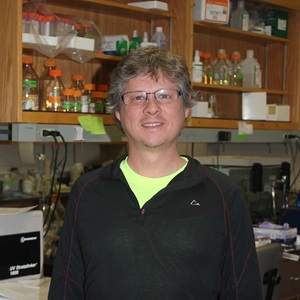Scott Grieshaber
Scott Grieshaber
Professor
Gibb Hall 133
208-885-5068
Dept. of Biological Sciences
University of Idaho
875 Perimeter MS 3051
Moscow, Idaho 83844-3051
Research: Biomedical Science, Cellular & Molecular Biology
- Ph.D. Molecular Biology, University of Wyoming, 2000
- B.S. Microbiology, Colorado State University, 1991
My laboratory studies the pathogenesis of the obligate intracellular bacterial pathogen Chlamydia. In my lab we pursue two main areas of interest: 1) understanding the cytological effects of chlamydial infection on the host cell, and 2) understanding and dissecting the mechanisms of chlamydial differentiation with an eye to developing novel genetic tools in this difficult to manipulate pathogen.
Intracellular bacterial pathogens are a diverse group of bacteria with an acutely adapted life cycle. These bacteria enter and exploit the intracellular environment of a eukaryotic host cell for replication and survival. The study of this class of pathogens is uniquely challenging as these organisms are dependent on the host cell for many aspects of their life cycle. Gaining access to and utilizing the resources of the host cell depends on a complex interaction between the host and pathogen. Throughout my career my research interests have focused on the intimate interaction between host cells and these pathogens. Although I have contributed to the understanding of pathogenesis in both Coxiella burnetii and Rickettsia species, my current work focuses on the pathogenesis of Chlamydia.
Chlamydiaceae are obligate intracellular bacterial pathogens which, depending on the species, cause a wide range of disease in both humans and animals. Members of the this group are the leading cause of bacterial sexually transmitted disease in humans, the leading cause of infectious preventable blindness in developing countries and a major source of community acquired pneumonia, bronchitis and sinusitis. Related Chlamydia pathogens are responsible for similar diseases in ruminants, cats, birds and rodents. In women, untreated Chlamydia genital infections can result in devastating consequences such as pelvic inflammatory disease, ectopic pregnancy, and infertility. Chlamydia trachomatis infections are also strongly epidemiologically linked to increased rates in cervical cancer, the second most common cancer of women worldwide.
Chlamydia undergo a tightly regulated developmental cycle which begins with the infection of the host cell by the metabolically inert, spore-like elementary body (EB). Upon infection, the EB differentiates to the non-infectious metabolically active reticulate body (RB) which divides repeatedly by binary fission within a pathogen modified endocytic vacuole. After multiple rounds of binary fission a subset of RBs differentiate back to the EB which in turn infect neighboring cells upon release by cell lysis or inclusion extrusion.
My laboratory pursues two main areas of interest:
- understand the cytological effects of infection on the host cell, and
- understand and dissect the mechanisms of chlamydial differentiation with an eye to developing novel genetic tools in this difficult to manipulate pathogen.
- Determine the mechanism by which CPAF causes both centrosome amplification and early mitotic exit. My lab’s studies revealed that the chlamydial protease CPAF is a necessary factor causing DNA segregation errors in infected cells through its induction of centrosome amplification and early mitotic exit. We are now in the process of describing the exact mechanism through which CPAF acts to cause these disparate phenotypes.
- Determine the chlamydial proteins involved in minus end microtubule trafficking. In an effort to identify the secreted chlamydial effector responsible for centrosome association as well as those effectors responsible for inclusion migration, we are undertaking a high content screening approach utilizing a Chlamydia mutant library to identify mutants that differ in this process.
- Determine chlamydial chromatin structure during development in host cells and effect of EB energy metabolism on initial chromatin decondensation. A key element in the transition between the infectious and vegetative chlamydial cell type is the structure of the chlamydial nucleoid. The EB nucleoid is formed by two chlamydial histone related proteins, HctA and HctB, which, immediately upon infection, are released from the chromatin and slowly degraded. New histones are expressed late in the chlamydial cycle concomitant with re-compaction of the chromatin, down regulation of gene expression and RB to EB differentiation. This critical pattern of repression and derepression places the chlamydial histones at the apex of the regulatory circuits that regulate the developmental cycle. We are currently investigating HctA and HctB chromatin binding dynamics as well as the role that histones play in gene expression during development using a combination of in vitro and in vivo assays combined with DNase-seq and ChIP-seq strategies.







